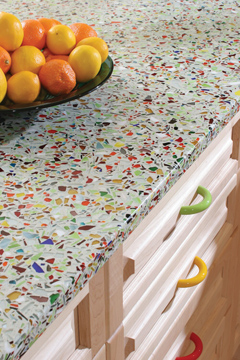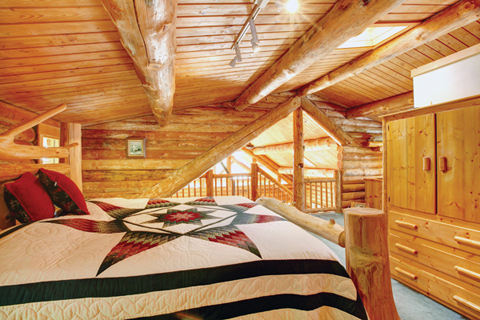You hear a lot of lingo when talking about the environment and building: LEED certification, efficiency, green building, eco-friendly, sustainability. It can be overwhelming! But the simple truth is that making sensible choices in your home’s design can lead to lifelong benefits. A home that’s easy on the environment will also have lower annual operating costs, higher resale value, will consume less energy and water, and be a healthier place to live for years to come. Here are some areas of the interior of your home where small changes can make a big impact.

www.vetrazzo.com
Kitchens
Appliances can be a real drain on resources. Look for EnergyGuide labels, which show the annual energy consumption and operating cost for appliances like dishwashers, ovens and stoves, and refrigerators. One feature that improves the energy efficiency of dishwashers is a booster heater, which increases the temperature of the water entering the dishwasher to the 140ºF recommended for cleaning. Dishwashers with booster heaters may cost more initially, but recoup that cost in energy savings in about one year if you lower the water temperature on your home’s water heater.
Refrigerator models with the freezer on top (rather than on the bottom or side-by-side) are more energy efficient, and if you don’t really need the ice-maker or filtered water, you can save energy (and money) by choosing models without those features.
Consider using green materials for cabinets and countertops. Cabinets made of particleboard and medium density fiberboard often contain toxic glues and sealants. Instead, choose exterior-grade plywood with a low-VOC (volatile organic compounds) wood finish for beautiful cabinetry that doesn’t compromise air quality in your home. For countertops, explore eco-friendly materials like recycled glass (sometimes called terrazzo), solid-surface paper composite, or even stainless steel.
Lighting
Lighting is responsible for approximately 10 percent of an average home’s electricity consumption, but you can minimize the use of electric lighting by maximizing natural light sources. Strategically placed windows and skylights can keep your home bright and airy.
For the light fixtures you do need, choose ENERGY STAR®-rated fixtures and use energy efficient bulbs, like LEDs or compact fluorescent bulbs. Timers, occupancy sensors, and dimmers can help fine-tune lighting use. You can also install recessed light fixtures or “cans” that are rated for contact with insulation and are air tight (ICAT rated); recessed fixtures that are not air tight should be avoided. You can find specifications online at energy.gov.
Bathrooms
Low-flow is the way to go where bathroom fixtures are concerned, so look for WaterSense labels for this room to indicate efficient fixtures that don’t skimp on performance. Water-Sense-rated fixtures perform just as well (often even better) than less efficient models and are typically 20 percent more efficient. Look for showerheads with a flow rate of less than 2.5 gallons of water per minute (gpm); to earn a WaterSense label, showerheads must use less than 2.0gpm. Low-flow sink faucets are also a good idea, or you can add an aerator to an existing faucet. Don’t forget toilets—they are the main source of water use in a home, but you can save 20 to 60 percent by choosing a model that has earned a WaterSense label.
 Wall Coatings
Wall Coatings
Paints and stains with low or zero VOCs are the best choice for wall coatings. VOCs can cause a variety of ailments, including respiratory irritation, headaches, and nausea. Some paints contain formaldehyde, which is carcinogenic. When used indoors, the concentration of VOCs in the air can reach toxic levels, so be sure to allow for maximum ventilation. You can also find paint products made from synthetic petroleum and all-natural ingredients. Be especially wary of the toxicity of paints and stains used in rooms that children will be spending a lot of time in, like a nursery or play room.
Flooring
Wood floors are a durable, natural complement to any log home, and you can make them more environmentally friendly by choosing reclaimed wood or certified sustainable hardwoods. Be cautious of flooring sealed with chemicals like formaldehyde or polyurethane, which many people are sensitive to. Other durable flooring materials, like tile or sealed concrete, are good choices for kitchens and bathrooms, and they won’t harbor dust and mold.
Carpets may feel nice under your feet on a chilly morning, but they can also pose environmental and health problems. Carpet and the adhesive used during installation can emit VOCs, so if you are installing carpet be sure to have adequate ventilation. Look for recycled or recyclable brands with low or no VOCs. Even better? Sustainable natural materials like wool. Still, carpet is an attractive home for allergens, so it’s best used in areas that will be easy to keep clean and dry.
While you’re planning your floors, now’s the time to think about installing radiant heat below the finished floor. Dry radiant systems heat the flooring and the surrounding air, for an evenly heated room. Radiant heat eliminates the dust and noise that can be associated with forced-air heat systems, and manufacturers claim energy savings of 20 to 40 percent.
Air Conditioning
Air conditioners are a big culprit not only of energy consumption but also of pollution, releasing an average of two tons of carbon dioxide per household into the atmosphere each year. Some of the more toxic refrigerants are being phased out and replaced by ozone-safe hydrofluorocarbons (HFCs) and alternative refrigerants such as ammonia, but it still makes sense to reduce air conditioner use.
Choose a high-efficiency model for your home and keep it maintained for optimal performance. You can also use passive solar design principles to reduce your need for air conditioning: use awnings and window coverings to provide shade, install low-e windows, make sure your home is well-insulated, and use ceiling fans to circulate air throughout the house.

